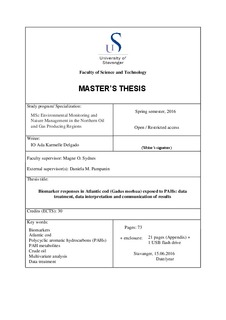| dc.contributor.author | Delgado, IO Ada Karmelle | |
| dc.date.accessioned | 2016-09-26T13:17:21Z | |
| dc.date.available | 2016-09-26T13:17:21Z | |
| dc.date.issued | 2016-06-16 | |
| dc.identifier.uri | http://hdl.handle.net/11250/2410623 | |
| dc.description | Master's thesis in Environmental monitoring | nb_NO |
| dc.description.abstract | The evaluation of multivariate statistical analysis to provide a simplified output based on biomarker responses is presented in this study. Biomarker responses obtained from two separate exposures on the effects of PAH on Atlantic cod were integrated using Principal Component Analysis (PCA), Integrated Biomarker Responses (IBR) and Bioeffect Assessment Index (BAI). The calculation of the indices was used to distinguish the different exposure groups within and between exposure setups. First exposure was designed to differentiate the effects of two PAHs and their first metabolic products in in vivo exposed Atlantic cod, and the second exposure was to reveal the effects of crude oil depending on the length of exposure. The sensitivity of the biomarker and the effectivity of using different suites of biomarkers in determining the variation between groups were also demonstrated. According to PCA results, the groups in the first exposure setup were not clearly discriminated but were differentiated in the second exposure, where the control group is clearly separated from the exposure groups after being exposed for 7 and 30 days. IBR was able to indicate the different groups for the second exposure setup, but only gave emphasis on the naphthalene exposed (high dose) group for the first setup. PAH metabolite biomarkers were consistently dominant in exposing the different groups in both exposures as shown by IBR and IBR/n. BAI reflected the dose-response relationship between the groups in the second exposure but was not evident on the first exposure. BAI is inclined to indicate the different health condition of the individuals in the groups in each exposure. PCA and IBR were able to acquire information about the biomarkers involved in the differentiation of groups. Based on the results, the biomarker responses were reflective of the effect of PAH on the health condition of individual samples and groups using the methods in the second exposure. The indices were able to extract consequent information out of the biomarker data and provide a simplified output despite their varying sensitivity, resolution and graphical representations. | nb_NO |
| dc.language.iso | eng | nb_NO |
| dc.publisher | University of Stavanger, Norway | nb_NO |
| dc.relation.ispartofseries | Masteroppgave/UIS-TN-IMN/2016; | |
| dc.rights | Navngivelse 3.0 Norge | * |
| dc.rights.uri | http://creativecommons.org/licenses/by/3.0/no/ | * |
| dc.subject | miljøovervåking | nb_NO |
| dc.subject | miljøteknologi | nb_NO |
| dc.subject | biomarkers | nb_NO |
| dc.subject | Atlantic cod | nb_NO |
| dc.subject | polycyclic aromatic hydrocarbons (PAHs) | nb_NO |
| dc.title | Biomarker responses in Atlantic cod (Gadus morhua) exposed to PAHs: data treatment, data interpretation and communication of results | nb_NO |
| dc.type | Master thesis | nb_NO |
| dc.subject.nsi | VDP::Technology: 500::Environmental engineering: 610 | nb_NO |

